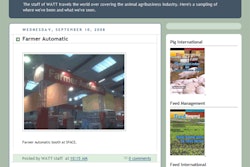Traceability was at the crux of an alert in the USA in May involving certain branded horse feeds. Contaminated grain resulted in what the originating company termed a "voluntary recall" or "product retrieval" after aflatoxin, a potentially life-threatening form of mycotoxin, was found in horse feeds that had been distributed to dealers in 17 East Coast states.
Traceability has limitations
Dealers were immediately notified and the affected lot numbers were removed from their stock. But traceability could go only so far. Many customers had transferred feeds they had purchased into their own containers and had discarded the bags on which the lot numbers were printed. All they could do was watch their horses, wait and hope. (To date, the company reports there have been no confirmed cases of aflatoxin-related horse illness from its recalled feeds.)
Traceability in that case was further complicated because neither consumers nor feed manufacturers knew the answer to the key question: where had the tainted ingredient come from? A spokeswoman for the manufacturer said the company traced the contamination to "a single ingredient from a single supplier." Although it ceased using that supplier, the company did not disclose its identity or the ingredient at issue. The possibility remained, therefore, that manufacturers of other brands of horse feeds could have purchased the same ingredient from the same supplier.
That prompted nationwide efforts in the feed industry to determine the nature and source of the affected ingredient. Some feed manufacturers and dealers said they had heard the culprit was peanut hulls. Those reports, however, were unconfirmed, and the company that supplied the contaminated ingredient to the feed manufacturer has remained anonymous.
But the incident raised awareness among horse owners about the importance of knowing what is in the feed they give their horses. While several types of mycotoxins can harm horses, aflatoxins are known to be particularly dangerous. Affected horses may show signs such as feed refusal, fever, weight loss, sluggishness and bloody diarrhea. Worse, the toxicity can be cumulative. At levels greater than 50 ppb (parts per billion), aflatoxins can cause liver and kidney damage, jaundice, birth defects, tumors and can suppress the immune function. Even at non-critical levels, mycotoxins can detract from a horse's performance, condition and appearance. Some have suggested mycotoxins may also contribute to colic.
Feed customers are seeking to reduce these threats by buying grain from manufacturers of premium horse feeds which utilize ingredients that inhibit the effects of mycotoxins. Traceability is also easier to determine with such manufacturers, many of whom add to their feed name-brand products available only from proprietary sources. Not all feed companies, however, are as careful about where ingredients are purchased and subsequent quality testing of ingredients and additives coming into their facility, said Dr. Amy Gill, an equine nutrition consultant in Lexington, Kentucky, USA.
Quality control measures
"Consumers need to be aware of this fact and ask questions if they are unsure of the quality control measures in place for their brand of feed. If the answers don't suffice, find another brand. Purchasing feed from a reputable manufacturer lessens the chance of contamination," she said. Traceability and ingredient sourcing are "the sole responsibility of the feed manufacturer" and are based upon the quality control measures a company has in place to prevent contamination of feed made in its facility, she added.
While cases of horse feed contamination have been rare, even general nutrition concerns underscore the importance of traceability in horse feeds. Does it really matter that selenium, for example, is contained in some complete and supplemented feeds? As with numerous other grain ingredients, all selenium is not created equal. A feed whose label lists selenium as an ingredient may contain the organic or inorganic form. Organic selenium is far more bio-available—and therefore provides more effective nutrition—to horses than inorganic types. For reasons such as this, horse owners and nutritionists are increasingly asking the source of ingredients in feed formulations.
If the label doesn't specify the source of its selenium or any other component, customers can inquire whether the feed contains the specific name-brand product they desire. Feed manufacturers who are unwilling to provide such information risk a customer changing to a manufacturer whose formula does include the ingredient source. Another option is for customers to research whether a specific desired ingredient can be purchased separately and top-dressed, as can be done with some organic digestive aids, for example, available in feed stores or online.
Taking such extra steps is worth the effort to hands-on horse trainers like Richard Ketch, owner of Equine Transitions in Lexington, Kentucky, USA, who has long mixed his own feeds for his string of thoroughbred racehorses.
His feeding program is based on whole (unprocessed) grains, such as rolled oats and barley, and individual organic supplements he uses to "tweak" the recipe for individual horses.
"I am the front-line defense for my own health, and I am the same for my horses," said Ketch. "Sure, it's easier to buy a bag of sweet or complete feed, but how do you know from week to week what's in there?"
Some horse feed formulas remain constant. But with the price of ingredients continuing to climb, more are being manufactured using "least-cost" formulations which may mean ingredient sources could change from one batch to the next.
Least-cost consequences
The high price of commodities and ingredients has forced even some globally recognized brands to use least-cost formulas to stay competitively priced. One week grain mixes may contain peanut hulls, the next week corn screenings, perhaps the following a soy byproduct. Such variations greatly complicate traceability, making it difficult—if not impossible—for customers to ascertain what is in the feed.



.jpg?auto=format%2Ccompress&fit=crop&h=167&q=70&w=250)













